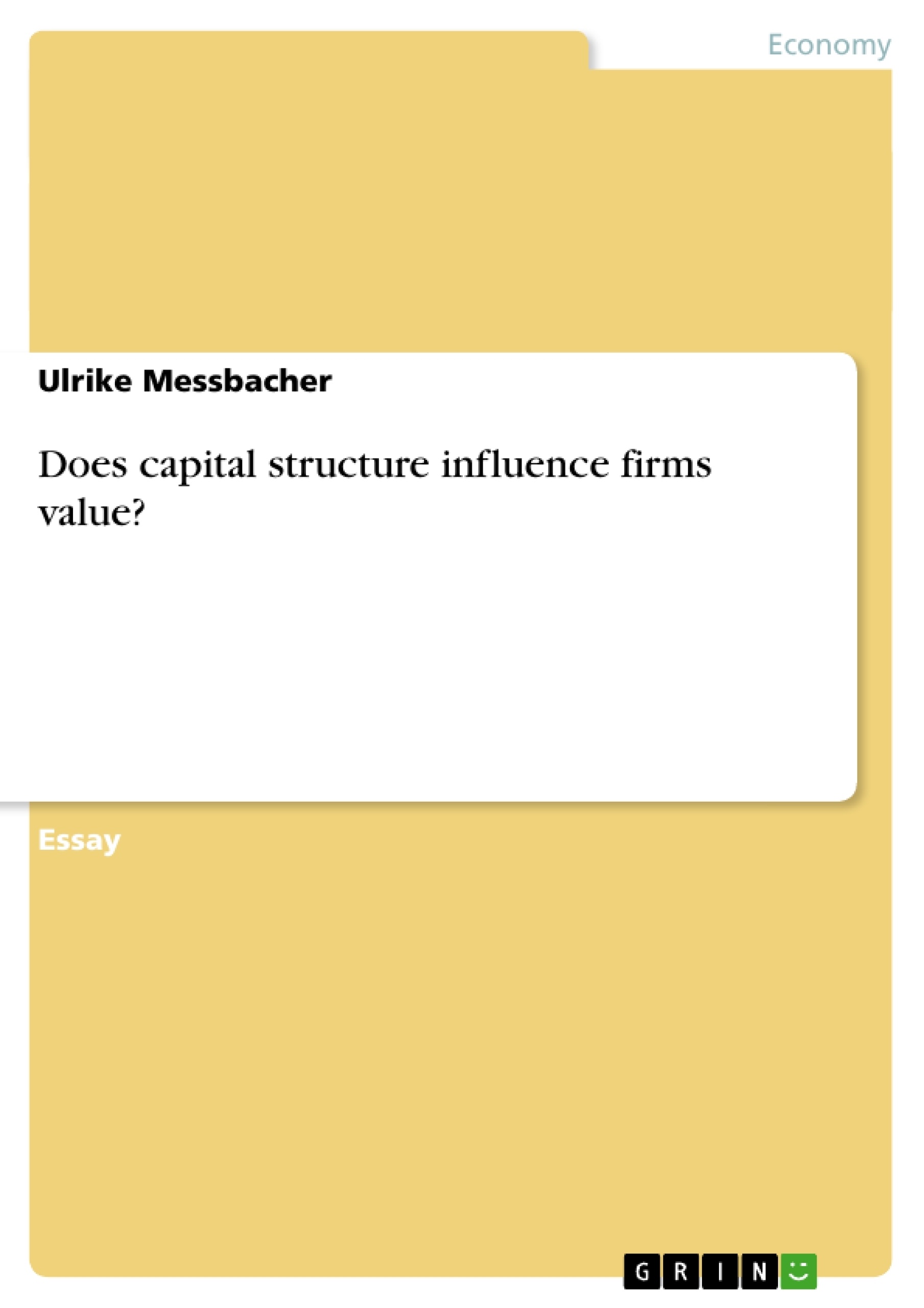In accordance with the Signalling model by Ross (1977) an increase in gearing represents, in term of a company’s prospective cash flows, a positive signal to external investors. Because, due to the higher risk of financial distress, companies with less optimistic market prospective tend to avoid additional financial obligations. This implies that an increasing indebtedness means a higher quality of business and therefore better valuation. This leads, in turn, to the assumption that the corporate management can influence a firm’s value by changing its capital structure. If capital structure can affect value, how can firms identify an optimal capital structure and what will it look like? It is that mix of debt and equity that maximises the value of a firm and, at the same time, minimise overall cost of capital. In their seminal article, published in 1958 and 1963, Modigliani and Miller argue that under certain assumptions the value of a firm i s independent of its capital structure, but with tax-deductible interest payments, they are positively related. Moreover, there are other approaches with partly contradictory perceptions. For instance, Myers (1998, cited in Fairchild 2003, p.6) argues that there is no universal optimal mix of debt and equity; in fact it depends on firms or industries, and therefore should be considered on a case-by-case basis. Other researchers have added market imperfections, such as bankruptcy costs, agency costs, and gains from leverage- induced tax shields to the analysis and have maintained that an optimal capital structure may exist (Hatfieldet al.1994, p.1).
First, this paper shows the basic determinants of a firm’s value in association with the impact of financial leverage on payoffs to stockholders. Secondly, it considers some arguments of capital structure theories, particularly the Modigliani and Miller theorem and the Traditional approach and contrasts them. Finally, the underlying factors of the model assumptions are examined and shown that they are important in the choice of a firm’s debt-equity ratio.
Table of Contents
- Introduction
- Cost of Capital and Firm Value
- Financial Leverage and EPS
- Capital Structure Theories
- Market Imperfections
- Conclusion
- References
Objectives and Key Themes
This paper examines the relationship between a firm's capital structure and its value. It explores how the mix of debt and equity can influence a firm's cost of capital, earnings per share (EPS), and ultimately, its overall valuation. The paper analyzes various theories and approaches, including the Modigliani and Miller theorem, the Traditional approach, and the role of market imperfections.
- The impact of financial leverage on firm value
- The relationship between capital structure and the cost of capital
- The influence of financial leverage on earnings per share (EPS)
- The role of market imperfections in capital structure decisions
- The existence of an optimal capital structure
Chapter Summaries
- Introduction: This chapter introduces the concept of capital structure and its potential influence on firm value. It highlights the Signalling model by Ross, which suggests that increased gearing can signal a positive outlook for a company's cash flows. The chapter also raises the question of how firms can identify and achieve an optimal capital structure.
- Cost of Capital and Firm Value: This chapter explores the relationship between a firm's capital structure, its cost of capital, and its valuation. It discusses the use of equity beta and the Capital Asset Pricing Model (CAPM) to calculate the cost of capital for both all-equity firms and firms with a mixed capital structure. The chapter emphasizes the importance of minimizing the Weighted Average Cost of Capital (WACC) to maximize firm value.
- Financial Leverage and EPS: This chapter examines the impact of leverage on the rate of return on equity and earnings per share (EPS). It explains how leverage can increase EPS when the interest rate is below the rate on equity, and vice versa. The chapter also presents a graphical illustration of the leverage effect, highlighting the break-even point and the variability of outcomes with different levels of leverage.
- Capital Structure Theories: This chapter delves into different theories related to capital structure, particularly the Modigliani and Miller theorem and the Traditional approach. It contrasts these theories and explores the implications of each for understanding the relationship between capital structure and firm value.
Keywords
This paper focuses on the key concepts of capital structure, firm value, cost of capital, financial leverage, earnings per share (EPS), Modigliani and Miller theorem, Traditional approach, market imperfections, and optimal capital structure. It explores the impact of these factors on firm value and the decisions companies make regarding their financing mix.
- Arbeit zitieren
- Ulrike Messbacher (Autor:in), 2004, Does capital structure influence firms value?, München, GRIN Verlag, https://www.hausarbeiten.de/document/48170


